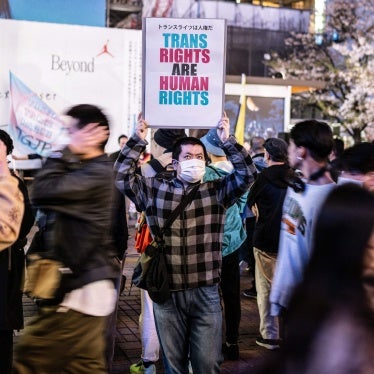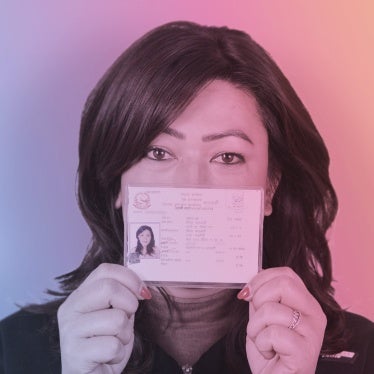July 20, 2015
Lok Sabha
Dear Members of Lok Sabha,
We are writing today to encourage your support for the Rights of Transgender Persons Bill (2014).
[1] The legislation, if passed, would bring India more closely in line with international best practices for legal gender recognition.
Human Rights Watch is an independent, international organization that monitors and reports on human rights in more than 90 countries globally.
In recent years, there has been considerable progress on rights of transgender people in India. In 2014, the Supreme Court in
NALSA v. India ruled that transgender people should be recognized as a third gender and not only enjoy all fundamental rights, but also receive special benefits in education and employment.
[2] The inclusion of a third gender category in the 2014 national census represented another important step toward improving access to services for transgender people.
[3] However, India’s transgender community remains exposed to widespread violence and discrimination for which the response of Indian authorities has been inadequate. The Rights of Transgender Persons Bill currently under consideration could make a substantial impact in the lives of transgender people.
Transgender people in India are socially marginalized and deprived of basic rights. They are frequently publicly ridiculed and excluded from general society. They endure discrimination and humiliation from the police and medical authorities.
[4] The Indian government policy of recognizing only two sexes had the effect of depriving transgender people of basic rights, including the right to vote, own property, marry, and claim a formal identity through a passport or other government identification. They have also been unable to secure government services such as food subsidies, education, employment, and health. Many
hijras, a highly visible segment of the transgender population, have no option but to either beg or engage in sex work. This exposes them to further violence at the hands of law enforcement authorities.
The draft law makes reference to India’s constitution, notably articles 14 (equality before law), 15 (prohibition of discrimination on grounds of religion, race, caste, sex or place of birth), 21 (protection of life and personal liberty), and 23 (prohibition of traffic in human beings and forced labour) to promote the fundamental rights of transgender persons. As noted by the Ministry of Social Justice and Empowerment in its 2013 Expert Committee report on transgender people, lack of recognition before the law, itself a human rights violation, presents a major barrier to transgender people in India realizing other basic rights. The report notes: “Article 5 of the Constitution identifies the persons who are entitled to be citizens of India. None of the conditions specified therein require a determinate sex or gender identity as a pre-condition of acquiring citizenship.”
[5]
The Rights of Transgender Persons Bill is aimed specifically at carrying out the Expert Committee report’s recommendations.
[6]
India’s progress
Some states in India have led the way in promoting rights of transgender people. For example, the Tamil Nadu Transgender Welfare Board (TGWB) has provided an effective model for outreach to and support of the transgender community in the state. In a policy brief on TGWB’s work, the United Nations Development Program (UNDP) noted that the office’s work was rooted in the “Lack of recognition (both at legal and administrative levels) of the gender identity of the transgender people,” which meant that they “could not access the existing government schemes even otherwise if they are eligible for those entitlements and benefits.”
[7] By giving transgender women specific identity cards, TGWB’s programming enabled their access to social services.
While the inclusion of a third gender category in the 2014 national census was a crucial and practical stride toward inclusion, research has shown that census data collection methodologies do not always capture the entire transgender population due to fears of prejudicial reactions, differing terminologies employed, and other factors in the data collection process.
[8] This means the approximately 500,000 transgender people counted in the census likely represent only a fraction of the transgender population, and significant nationwide rights reforms are needed to respect and protect the entire population – including those who live in hiding for their own safety.
[9]
Crucially, gender recognition procedures should allow applicants to self-identify as they wish, and not mandate a single category for everyone who wants to identify as something other than the sex that was assigned to them at birth.
Ensuring rights for all
In its ruling in
NALSA, the Supreme Court said that the government should follow the international conventions to which it is a party as well as the Yogyakarta Principles on the Application of International Human Rights Law in Relation to Sexual Orientation and Gender Identity, noting that the principles were “not inconsistent with the various fundamental rights guaranteed under the Indian Constitution.”
[10] The Yogyakarta Principles encourage countries to consider measures that allow all people to define their own gender identity.
[11]
One of the most fundamental barriers to realizing the human rights of transgender people, including protecting them from violence and discrimination, is their lack of access to having their gender identity legally recognized.
[12] When transgender people carry documents that list a sex or gender that does not match their identity and appearance, officials may subject them to humiliating and sometimes abusive scrutiny.
[13] As official documents are needed to perform a range of basic civic functions and access basic services such as acquiring housing and medical care, daily life can become immensely challenging – not to mention the risks and challenges associated with traveling, acquiring and maintaining employment, or other livelihood-related activities.
Principle 3 of the Yogyakarta Principles states that:
Everyone has the right to recognition everywhere as a person before the law. Persons of diverse sexual orientations and gender identities shall enjoy legal capacity in all aspects of life…. No one shall be forced to undergo medical procedures, including sex reassignment surgery, sterilization or hormonal therapy, as a requirement for legal recognition of their gender identity.
[14]
International professional bodies and experts have noted the importance of identity-based protocols for legal gender recognition. The World Professional Association for Transgender Health (WPATH), an international multidisciplinary professional association aimed at promoting evidence-based care, education, research, advocacy, public policy, and respect in transgender health, and comprised of over 700 members worldwide, in 2010 stated: “If a sex marker is required on an identity document, that marker could recognize the person’s lived gender.”
[15]
Obtaining recognition before the law can also impact rights to privacy and movement. The UN Special Rapporteur on the Promotion and Protection of Human Rights and Fundamental Freedoms while Countering Terrorism in 2009 mentioned transgender people’s right to recognition before the law, specifically as it related to the increased scrutiny they face: “Stricter procedures for issuing, changing and verifying identity documents, risk unduly penalizing transgender whose personal appearance and data are subject to change.”
[16]
The Convention on the Elimination of All Forms of Discrimination against Women (CEDAW) requires states to ensure that state policies and practices are not based on, or have the effect of reinforcing, gender stereotypes. According to article 5 of CEDAW, states should take measures to “modify the social and cultural patterns of conduct of men and women, with a view to achieving the elimination of prejudices and customary and all other practices which are based on the idea of the inferiority or the superiority of either of the sexes or on stereotyped roles for men and women.”
[17] The UN Committee on Economic, Social and Cultural Rights (CESCR) has said: “Gender identity is recognized as among the prohibited grounds of discrimination; for example, persons who are transgender, transsexual or intersex often face serious human rights violations, such as harassment in schools or in the workplace.”
[18]
The right to recognition before the law is protected under international human rights law, notably under the International Covenant on Civil and Political Rights (article 16)
[19] and CEDAW (article 15). The right to preserve one’s identity is guaranteed by article 8 of the Convention on the Rights of the Child. Article 8 specifies three aspects of identity—nationality, name, and family relations—but that list is not exclusive, and reasonably extends to the way one’s identity is reflected on state-issued documents.
[20]
The urgency of this legislation
India has an opportunity to be a regional and global leader on legal gender recognition for transgender people. At stake in this draft legislation is the fundamental dignity of a minority that faces numerous human rights violations. The ability to gain legal recognition according to their gender identity would represent the first step in addressing one underlying cause of these abuses.
Sincerely,
Meenakshi Ganguly
South Asia director
Human Rights Watch
[1] Rights of Transgender Persons Bill (2014), http://164.100.47.4/BillsTexts/RSBillTexts/PassedRajyaSabha/transgndr-RS%20pas-E.pdf.
[10] NALSA v. India, p. 59.
[13] Paisley Currah and Tara Mulqueen, “Securitizing Gender: Identity, Biometrics, and Transgender Bodies at the Airport,” Social Research 557, 577 n. 1 (2011).
[14] Yogyakarta Principles, principle 3.
[18] UN CESCR, General Comment No. 20: Non-discrimination in Economic, Social and Cultural Rights, 2009, para. 32.








